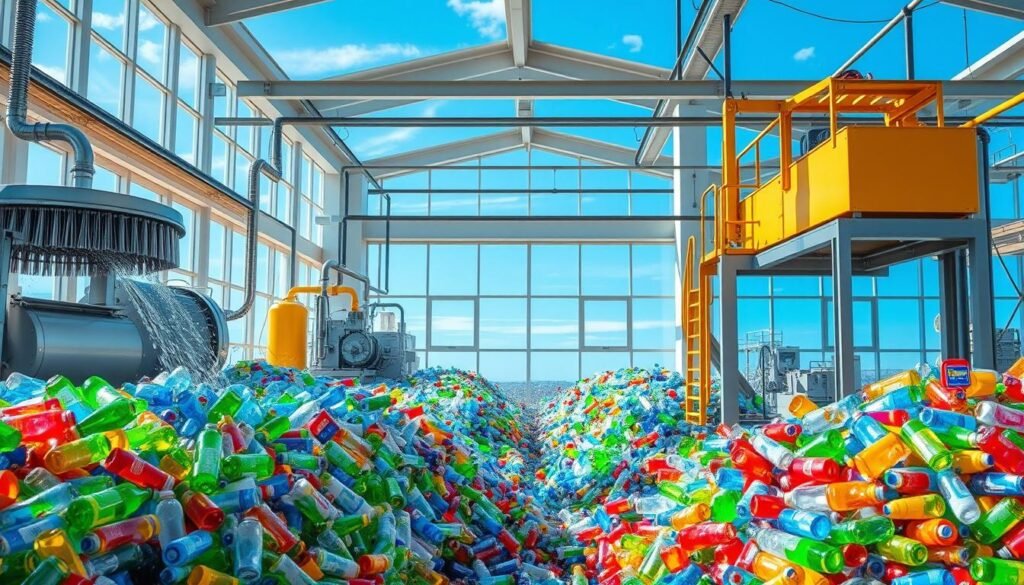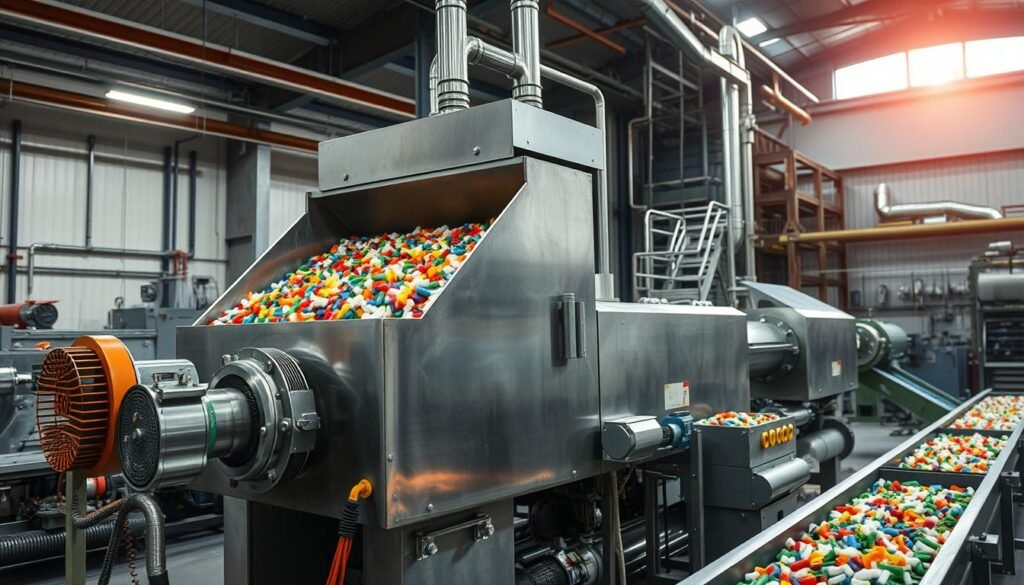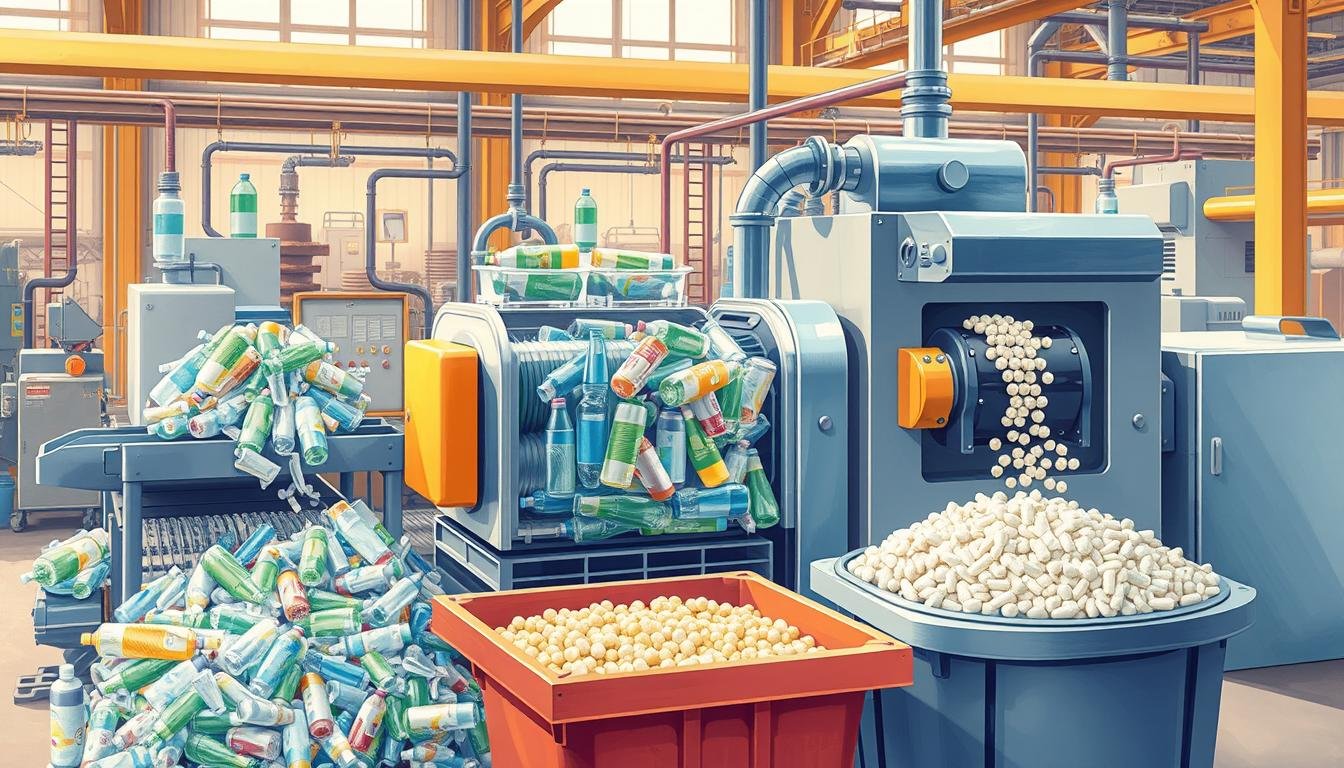In today’s world, being green is key. That’s why plastic recycling is so important. More people are recycling, so we need better plastic recycling machines to turn plastic into new things.
The plastic recycling process has many steps. These include collection, sorting, washing, shredding, and extrusion to make new plastic pellets1. Special machines are key to making sure the recycled plastic is good quality and sustainable.
Key Takeaways
- Plastic recycling is a crucial process for sustainability and resource conservation.
- Specialized machines are used to sort, clean, shred, and extrude plastic waste into new recycled materials.
- The plastic recycling process involves multiple stages, each requiring specific equipment and technologies.
- Choosing the right suppliers and machines is crucial for efficient and effective plastic recycling operations.
- Cooperation among various stakeholders is essential for successful plastic waste management and recycling efforts.
This article will explain plastic recycling machines. We’ll look at the recycling process and the important machines used. From collection and sorting to shredding, washing, extrusion, and pelletization, we’ll see how these machines turn plastic waste into valuable recycled plastic products.
Introduction to Plastic Recycling
Plastic recycling is key to tackling plastic pollution and cutting down on environmental harm. In the past 70 years, we’ve made 8.3 billion metric tons of plastic. About 6.3 billion metric tons of plastic waste has been made2. But, only 9% of plastic waste gets recycled2.
The Importance of Recycling Plastics
Recycling plastics is vital for many reasons. Plastic often ends up in oceans, rivers, and forests, hurting animals and marine life3. It also takes hundreds of years to break down, filling up landfills3. Recycling plastic cuts down on the need for raw materials, saves energy, and uses less energy than making new plastic3.
It also saves natural resources and cuts down on greenhouse gases, helping our planet3.
Benefits of Using Plastic Recycling Machines
Plastic recycling machines make recycling easier and more efficient. The recycling process has six main steps: collecting and distributing, sorting and categorizing, washing, shredding, identifying and separating plastics, and extruding and compounding2. Machines like washing lines, drying machines, labeling machines, and packaging machines help reduce plastic waste and pollution3.
Advanced machines, like the Retech plastic pelletizing machine system, bring new solutions to recycling. This system works with low-density plastic items and can re-pelletize different plastics, like film and fabric4. It can handle pollutants up to 5% and remove things like paper and rubber4.
In conclusion, plastic recycling and advanced machines are crucial. They help businesses and communities reduce plastic waste, support sustainability, and protect our environment for the future.
Collection and Sorting of Plastic Waste
The first step in recycling plastic is collecting and sorting it5. We get plastic from homes, businesses, and recycling centers. Then, it goes to Material Recovery Facilities (MRFs) and Plastic Recovery Facilities (PRFs) for sorting5. At these places, they use different methods like manual picking and machines to sort plastics by type5.
Now, sorting plants can handle over 100,000 tonnes of plastics a year. They make sure the sorted plastics are over 95% pure5. Laws like the Waste from Electrical and Electronic Equipment (WEEE) Directive help reduce waste and encourage better production and use5. This makes recycling more efficient and produces better quality plastics5.
Using digital tech like watermarking helps sort packaging waste better5. Companies like Unilever and Alibaba are using AI to quickly sort recyclable plastics5. This tech makes sorting plastics more accurate, making recycling better5.
| Waste Management Stages | Priority |
|---|---|
| Prevention | 1 |
| Preparing for reuse | 2 |
| Recycling | 3 |
| Recovery | 4 |
| Disposal | 5 |
The Waste Framework Directive says the order for managing waste is: Prevention, Preparing for reuse, Recycling, Recovery, and Disposal5.
Using ReLearn’s Nando AI made waste collection 58% more efficient6. Austria’s AI-Waste project aims to boost recycling by 10% with image recognition and data analysis6. The ReCircE project is working with 50 partners to increase recycled plastics in Industry 4.0 with a digital record for sorting and recycling6.
AI is changing how we sort waste, like Tomra Recycling Sorting’s machine that uses computer vision and deep learning6. Unilever and Alibaba are working on AI-powered machines for sorting plastic waste6. Hera Group and IBM Garage made an AI solution to identify waste types, improving recycling quality6.
“Harmonised waste collection processes lead to increased efficiencies and higher qualities and quantities of recycled plastics.”
Sorting plastic waste is key to recycling, and AI is making it better. This leads to more efficient and effective plastic recycling56.
Plastic Shredders and Granulators
Plastic recycling is a complex process. It starts with breaking down large plastic items into smaller pieces. This is done with plastic shredders and granulators. JianTai leads in offering solutions for plastic recyclers.
Types of Plastic Shredders
There are many types of plastic shredders for different plastics and needs7. Vecoplan makes over 300 types of shredders for plastics7. These machines work in big and small recycling plants around the world7. They can handle plastics like ABS, Acrylic, HDPE, and more7.
Plastic Granulators for Size Reduction
8 There are many machines for shredding and granulating plastics8. An upgraded granulator machine saves money by cleaning and cooling blades8. Single-shaft shredders shred many materials, including plastic and wood8. Double-shaft shredders are strong and cut big pieces of plastic8.
8 A pipe shredder system can handle long and big pipes, shredding up to 2000 kg/hr8. Rigid shredders are great for big pieces of plastic like lumps and rolls8.
“Vecoplan, a leader in size reduction technologies since 1969, provides comprehensive industrial shredders for recycling all types of plastics, offering installation, training, parts, and service for their machines and systems.”
7 Vecoplan’s shredders are popular for their flexibility and ease of use7. They have been leading in size reduction since 19697.
Plastic Washing Lines
Cleaning plastic waste before recycling is key. Plastic washing lines are vital in removing contaminants and labels. They make sure the plastic is clean enough for recycling. These machines are mainly rigid or film plastic washing lines.
Rigid Plastic Washing Line
Rigid plastic washing lines clean solid plastic items like containers and bottles. They use advanced cleaning methods like mechanical agitation and chemical treatment. This process gets rid of dirt and prepares the plastic for recycling9.
Film Plastic Washing Line
Film plastic washing lines are for cleaning plastic films and bags. They have special equipment for thin, lightweight plastics. These lines can clean many types of plastic scrap, including PP, PE, and PP woven bags10.
Both types of washing lines are key in recycling plastic. They make sure recycled materials are high quality. These machines help make recycling more efficient and reduce plastic waste’s harm to the environment.

“Investing in state-of-the-art plastic washing lines is a strategic decision that pays dividends in the long run, as it ensures the recycled plastic meets the stringent quality requirements of modern industries.”
– JianTai, Founder of ABC Plastics
Plastic Extruders
Plastic extruders are key in recycling plastic, turning old plastics into new materials11. They melt and shape the plastic into pellets. These pellets are then used to make new plastic products11.
The Precious Plastic Extrusion machine is a new way to recycle plastic11. It costs about €1200 for the Basic model and €2200 for the Pro model, not counting the motor11. This machine is great for recycling PP and HDPE plastics and can make a lot of new products11.
People all over the world use the Precious Plastic Extrusion machine to recycle and make new things11. Zelenew from Ukraine made a special way to use the machine and called it the Zelenew technique11. Working together in the Precious Plastic community helps fight plastic pollution11.
In the plastic recycling world12, twin screw extruders are getting more popular12. They help recycle plastics like HDPE, LDPE, PP, and PVC12. Companies like Bausano have systems to recycle plastics that are dirty or have prints on them12.
Plastic extruders melt and shape the plastic into different forms12. The cost depends on the material, screw length, and other parts12.
| Product | Application |
|---|---|
| Pipes | Water, sewage, gas, and electrical conduit |
| Window & Door Profiles | Building and construction materials |
| Technical Profiles | Industrial and automotive components |
| Pellets | Raw material for new plastic products |
| Medical Devices | Tubing, catheters, and other medical equipment |
“Collaborating with others in the Precious Plastic community is encouraged to tackle plastic pollution on a larger scale.”
Dryers and Separators in Plastic Recycling
In plastic recycling, dryers and separators are key. Plastic recycling dryers remove moisture from plastics before melting or extrusion. This step makes the recycled materials better and uses less energy13.
Plastic recycling separators sort plastics by density, size, shape, and color. This helps recycle different plastics better, making the recycled materials more valuable and sustainable13.
| Dryer Type | Residual Moisture Content | Key Features |
|---|---|---|
| Step Dryer | Less than 1% for flakes, 0.4% to 0.06% for granules14 | Step-shaped basket screen and rotor, high throughput, compact design, easy maintenance, low operating costs14 |
Using plastic recycling dryers and separators, companies like JianTai improve moisture removal in plastic recycling. This leads to better material quality and less energy use13. These solutions make plastic recycling better and help the planet, pushing us towards a more circular economy13.
plastic recycling machine
To make plastic recycling better and greener, we need advanced machines. These machines include shredders, granulators, washing lines, extruders, and pelletizers. They make recycling faster and improve the quality of recycled plastic. This also cuts down on carbon emissions a lot compared to making new plastic15.
JianTai leads in making plastic recycling better with their technology. They’ve set up over 80 plastic recycling plants worldwide. These plants recycle more than 700,000 tons of plastic every year15.
JianTai is all about new ideas and doing things better. They’ve worked on over 89 projects around the world. They have more than 300 full-time workers and over 113 machine patents15. Their machines can process 500 kg of HDPE bottles every hour, making sure the recycled plastic is top quality15.
Using advanced machines, companies can make recycling easier and cut down on carbon emissions. JianTai offers complete solutions with their experience and new tech. They are a key partner in making a greener future16.
Pelletizers and Melt Filters
The last steps in recycling plastic include plastic pelletizers and melt filters. Pelletizers chop and melt plastic into small, uniform pellets. This makes it easy to transport and reuse, keeping the size and shape the same17. This step is key for making top-notch recycled plastic pellets.
Melt filters are also key for quality. They take out any dirt or bits from the melted plastic before it’s shaped18. This makes sure the recycled plastic is clean and meets today’s recycling standards.
Versatile Recycling Solutions
PURE LOOP, part of EREMA Group GmbH, has been recycling plastics for years. They focus on recycling production scraps efficiently17. Their ISEC evo pelletizing machine is strong, saves money, easy to use, and can make a lot of pellets17.
PURE LOOP uses a special shredder/extruder combo for flexibility17. Customers like CEO Axel Rivera from Foam Industrial say they get more flexibility, make more pellets, use less power, and work more efficiently with PURE LOOP’s machines17.
| Melt Filter Type | Advantages |
|---|---|
| Plate Filter | – Basic design – Low cost |
| Dual-Piston Filter | – Continuous operation – Moderate cost |
| Self-Cleaning Filter | – Lowest labor cost – Largest filtration area – Automatic screen change – Best quality final product |
The European Union wants to cut down on packaging waste by 2030. This means we need better recycling methods, like PURE LOOP’s machines17. Melt filters are key for making sure recycled materials are top quality18. PURE LOOP can make a 10% recycled content in strong PP nonwovens17.
“The powerful machine is stated to offer more flexibility, outputs, lower power consumption, and increased efficiency by satisfied customers like CEO Axel Rivera from Foam Industrial.”
PURE LOOP’s ISEC evo tech also helps plastics makers like Arexim in Bulgaria go waste-free. They recycle injection moldings efficiently17.

As we want more sustainable solutions, machines like PURE LOOP’s will be key. They turn plastic waste into high-quality recycled pellets1718.
Conveyors for Recycling Machines
Conveyors for recycling machines make the plastic recycling process more efficient and automated19. They connect different recycling tools, like washing and pelletizing lines, for a smooth flow19. They also have metal detectors for extra safety and to make the recycling gear more reliable19.
Belt conveyors can move many types of plastic waste, like flakes and bags20. Nip rollers can handle many rolls at once, cutting down on manual work20. Screw conveyors are great for moving small plastic pieces with little energy20.
Karl Schmidt Mfg Inc. has led in making custom recycling systems since 197819. They offer many conveyor types, including steel belt and chain conveyors19. These conveyors can handle recyclables like paper, plastic, glass, and metal19.
Karl Schmidt focuses on size, material handling, and custom needs when making conveyors19. They stand out with their experience, great customer service, quality, innovation, and custom options19.
Maintaining and Purchasing Recycling Conveyors
Keeping recycling conveyors running well means checking them often, cleaning, lubricating, and getting professional help19. When buying a conveyor, think about the material, how much you need, the space, and your budget19. Safety tips include regular checks, training workers, adding safety features, and following OSHA rules19.
DeHart Recycling Equipment makes custom conveyor systems for recycling21. They design, make, and put together slider bed and chain-drive conveyors21. For moving light materials, use small mobile conveyors. For heavy loads, go with heavy-duty slider bed conveyors21.
| Recycling Machine | Conveyor System |
|---|---|
| Repro-One | Belt conveyor for efficient plastic waste feeding, maximizing production rates20. |
| Repro-Flex | Nip rollers for gentle grip on plastic waste, ensuring consistent feeding without damage20. |
| Repro-Direct | Screw conveyor to feed plastic waste directly, enhancing efficiency while accommodating different material sizes20. |
To buy a recycling conveyor from Karl Schmidt Mfg Inc., visit their website or call (303) 287-740019.
Environmental Impact and Sustainability
The environmental impact of plastic waste is growing fast. Only 9% of all plastic made is recycled22. We need to act fast because we make about 380 million tons of plastic every year22. The recycling of plastic has changed a lot over the years to find better ways to solve this problem.
In the 1980s, more people wanted recycled materials, so recycling got better22. A new technology called near-infrared spectroscopy helped sort plastics better22. Then, the 1990s and 2000s brought even more advanced machines that could handle many types of plastics22.
Reducing Carbon Emissions with Plastic Recycling
New recycling machines are key to fixing the plastic waste problem and being more sustainable. They help keep plastic out of landfills and use less energy, which cuts down on carbon emissions22. Now, things like artificial intelligence and robots are making recycling even better22.
Today, we have smart machines that can sort and recycle plastic with little help from people22. Recycling plastics involves cleaning, sorting, and melting them to make new things22. These machines work better because they have special controls and software22.
New ways to recycle plastics are being found, like chemical and biological recycling22. Also, mobile recycling units are easier to use, especially in places far from recycling centers22.
“Recycling plastic can help reduce greenhouse gas emissions23. Companies can use less energy by adding heat jackets to machines23.”
| Key Statistic | Value |
|---|---|
| Global recycling rates for plastic | 9%24 |
| Annual global plastic production | Over 400 million metric tonnes (Mt)24 |
| Plastic not recycled | 6900 Mt24 |
| Thermoset plastics as a share of total plastic production | One-third24 |
| Essentra Components’ increase in recycled LDPE usage | From 40% to 50%23 |
The recycling industry is changing to use better machines and methods. This helps reduce the harm plastic waste does to the environment. By using new technology, the industry is working to cut down on carbon emissions and make recycling better2223.
Customized Solutions for Plastic Recycling
At JianTai, we lead in customized plastic recycling solutions. We know each recycling operation has its own challenges. That’s why we offer tailored recycling equipment and plastic recycling services. Our experts work with businesses and cities to make plastic recycling better, more efficient, and good for the planet.
We can make our machines work with many kinds of plastic, like PET bottles and thin film25. We’ve made lots of recycled products and helped create jobs, all while keeping plastic out of landfills25. Our machines and molds are made in Austria, meeting all safety and standards25.
If you’re a small business or a city looking to recycle better, JianTai has what you need26. Our small machines are easy on the wallet and can handle a lot of plastic26. They can process up to 50 kg an hour or 1,100 kg a day, making recycling easier26.
| Recycling Process | Key Features |
|---|---|
| PET Bottle Recycling | |
| Tire Recycling | |
| Plastic Film Recycling |
At JianTai, we aim to give our clients customized plastic recycling solutions that make a difference. We offer everything from advanced washing systems to granule machines that turn waste plastic into something new27.
“By recycling waste materials, businesses can create a new source of revenue and increase profits.”26
Conclusion
This article has shown us how plastic recycling machines change plastic waste into useful materials28. These machines help cut down on plastic waste in landfills. This stops pollution and protects our environment28. By recycling plastic, we use less oil and save natural resources28.
Using plastic recycling machines cuts down on CO2 emissions. It means making less new plastic, which helps fight climate change28.
The plastic recycling process has many steps, like collecting, sorting, and making pellets29. Machines make each step better, ensuring quality and sustainability29. Recycling plastics saves energy and materials, which lowers costs29.
These machines help move towards a circular economy in the plastics industry29.
As we look for ways to manage waste better, this article shows why advanced plastic recycling machines are key30. Recycling plastics stops them from polluting our land, oceans, and water30. These machines sort and process plastics well, saving resources and reducing waste30.
Using these machines helps us fight plastic pollution and save natural resources30. It also means less waste in landfills and supports a circular economy.
The recycled plastic applications are growing. The JianTai team is working on new plastic recycling solutions to tackle the plastic pollution crisis30. With advanced machines, companies can work better, make better recycled plastics, and help create a sustainable future.
FAQ
What are the key stages of the plastic recycling process?
The key stages include collecting, sorting, shredding, washing, extruding, and pelletizing.
What is the role of plastic shredders and granulators in the recycling process?
Plastic shredders break down big plastic items into smaller pieces. Granulators then make these pieces even smaller. This makes processing easier.
How do plastic washing lines contribute to the quality of recycled materials?
Washing lines clean the plastic by removing dirt, labels, and leftovers. This makes sure the recycled plastic is good enough to use again.
What is the function of plastic extruders in the recycling process?
Extruders melt the cleaned plastic into a continuous form. This makes recycled plastic pellets that can be used to make new products.
How do dryers and separators contribute to the plastic recycling process?
Dryers take moisture out of plastics before melting or extruding. This makes the recycled materials better and uses less energy. Separators sort plastics by type, helping to recycle them better.
What are the benefits of using advanced plastic recycling machines?
Using advanced machines like shredders, granulators, washing lines, extruders, and pelletizers makes recycling faster and better. It also makes recycled materials better and cuts down on carbon emissions.
How do pelletizers and melt filters contribute to the production of high-quality recycled plastic pellets?
Pelletizers turn plastic into small pellets for easy transport and reuse. Melt filters clean the molten plastic of last bits, making sure the pellets are pure and consistent.
What is the role of conveyors in the plastic recycling process?
Conveyors link different recycling machines together, making recycling smooth and automatic. They can also have metal detectors to make recycling more reliable and long-lasting.
How does plastic recycling contribute to sustainability and reducing environmental impact?
Recycling plastic keeps it out of landfills and incinerators. It uses less energy, which means less carbon emissions. This makes recycling a key part of being green.
How can JianTai’s customized solutions for plastic recycling meet the unique requirements of clients?
JianTai offers flexible solutions that fit different materials, products, and recycling needs. This helps clients improve efficiency, quality, and their environmental impact.



